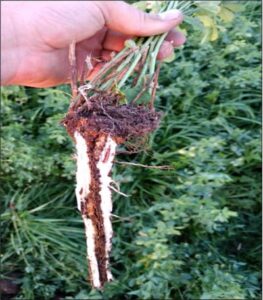Kyle Hilger works on his family farm in Bloomer, Wisconsin.
I started working on my family’s dairy farm after high school starting in the winter of 2017. I continued my education and obtained my crops and soil science degree from UW-River Falls with a dairy science minor, which I knew would help me in my future career in agriculture. Every winter and summer while I attended college I worked on the farm. We milk 380 Holstein dairy cows and have 2,000 acres growing a mix of corn, soybeans, grasses, and alfalfa for forage.

When asked about the impacts of extreme weather on alfalfa production, one event stood out in my mind from past seasons. I even made research poster about the phenomenon with Dr. Newman, a professor from UW-River Falls, about the events from the winter of 2018-2019. The winter season like many other years started off to a slow start with only an inch of snow accumulating by December. Then the temperature started to drop to the 5-degree Fahrenheit mark in January.
Alfalfa is perennial, which means they come back year after year. They can withstand temperatures down to five degrees Fahrenheit over the winter months. Under this temperature the crown/root of the alfalfa plant can be injured or killed. The rule of thumb is that you need ten centimeters of snow for that alfalfa to be protected. This situation is not usually a problem for us.
With the lack of snow cover in December, we started to worry a little bit. But then, in January, we had polar vortex. When the polar vortex came through it dropped the temperatures well below negative 30 degrees Fahrenheit. We only had about one inch of snow on the ground still and this had us very worried. These cold temperatures did not go away, and it stayed below zero degrees for almost twenty days.
Eventually we got snow we needed for adequate protection, but the damage was already done to the alfalfa plant. We knew then that there would be problems getting enough tonnage out of these fields to supply out dairy herd with enough feed. Then, in February alone, we received three feet of snow. Temperatures quickly changed in March and rose above freezing, starting to melt all the accumulated snow. When all the snow melted in the Spring thaw, the ground quickly became saturated, and it started to pool up in the low areas in our fields. We knew that many of the submerged alfalfa plants would not survive.

Then, all the water in the fields froze due to another late cold snap. When the water froze it lifted the plants out of the ground and tore them off from their roots killing any plants trapped in these ice sheets. My uncle said he’d never seen or heard of an event like this happen in his 40 years of farming.
All these events reduced the stand count of many of our alfalfa fields. We knew this was a bad scenario. We thought about what stands to rotate out and what fields we could plant new stands in. Many of our younger stands received the most winter kill. We had to find a way to increase the tonnage in these fields to make them last until it was their time to be rotated out of alfalfa production.
In June 2019, after our first cutting, we tried to repair our younger stands as best we could with a method not implemented on our farm before. After a rainstorm when the ground was soft, we no till drilled a series of forage plants like Italian rye, reed canary, and red clover into the winterkill areas. With a little luck and a lot of patience, the plants grew. With the repairs, we were able to obtain some lost tonnage for the last cutting of the 2019 year which gave us peace of mind going into the Fall months about our haylage supply.
When asked what I would tell other producers when faced with an unusual weather event like this, my advice would be, “Don’t Panic.” Things always seem worse than they are. Talk to other neighbors and growers for help or advice. We consulted our agronomist at our local co-op, and they helped create the forage mixture that we planted. Online research is always a great way to find information and to get answers fast from well documented sources. I personally like using the UW-Extension database for many of my questions.


In a closing question I was asked what I felt the future looked like for the next farming generations like myself in the face of the these increasingly occurring severe weather phenomenon. Different weather conditions and scenarios have been plaguing the progress of producers ever since people first started putting cultivated crops in the ground. The responsibilities of running a farming operation and dealing/relying with the weather is nothing new.
Improved technology and different growing methods will help play a pivotal role in the future of agriculture in response to our planet’s changing climate. The unknowns of climate change might seem a little overwhelming. But as a producer, I take one workday at a time. Plan for the future, create solutions when the unexpected occurs, and hope for the best.
The views and opinions expressed in this interview are those of the authors and do not represent official policy or position of the University of Wisconsin-Madison or the Wisconsin Initiative on Climate Change Impacts.